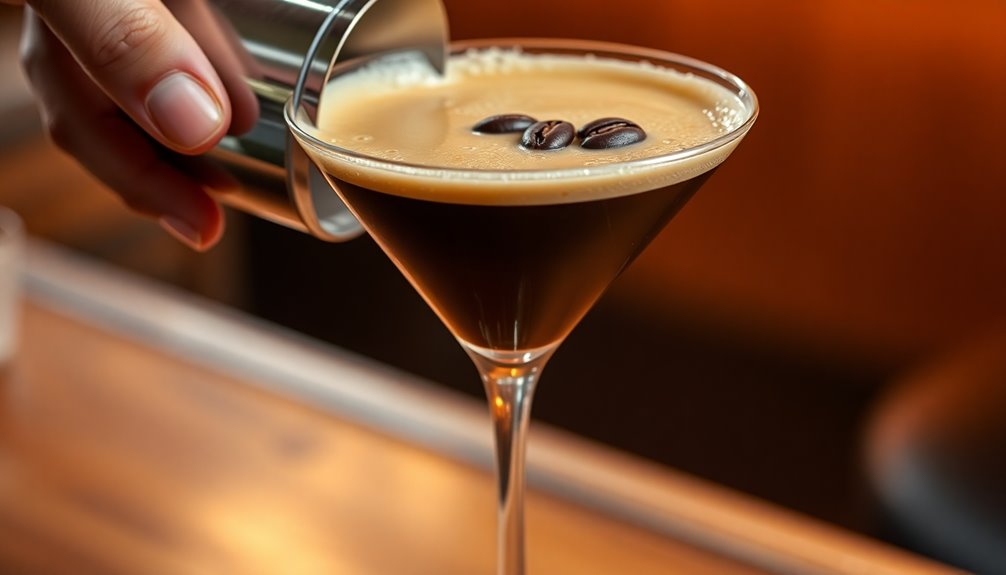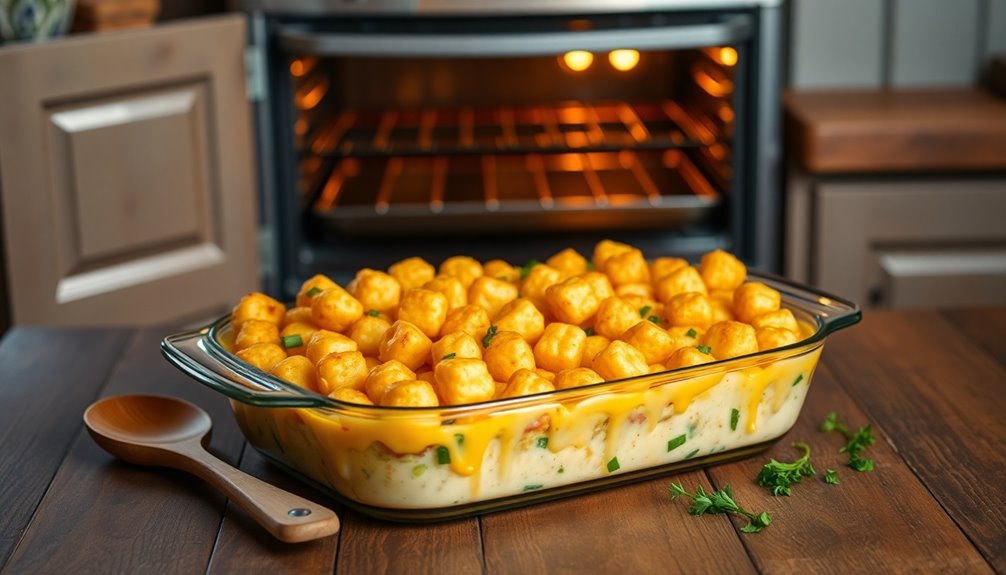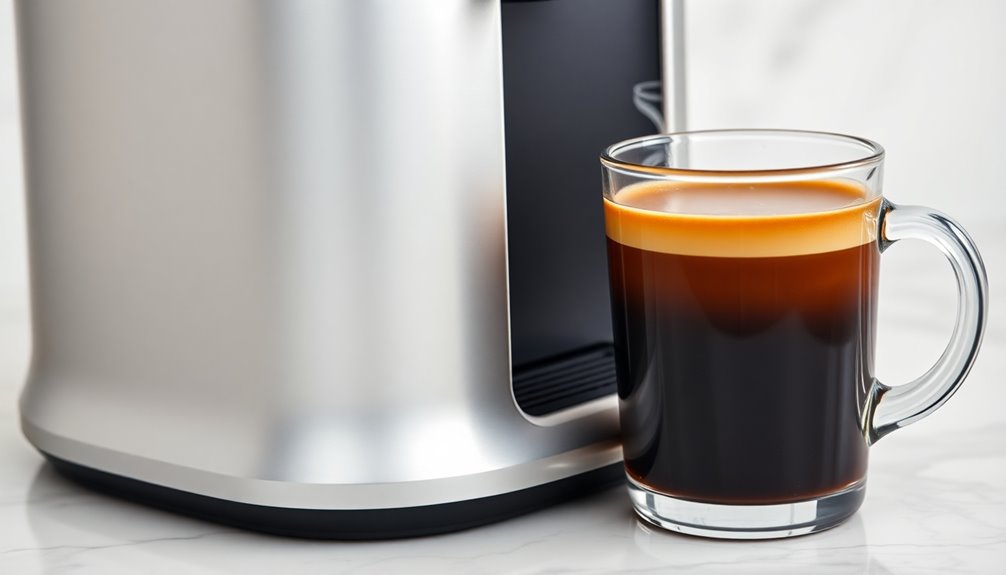When you think about cocktails that seamlessly blend the richness of coffee with the kick of vodka, the Espresso Martini stands out as a sophisticated choice. You might appreciate how its vibrant flavors come together with just a few key ingredients, each playing a crucial role in crafting the perfect drink. But before you gather your supplies and start mixing, consider the nuances of each component and how they can elevate your experience. There's more to this cocktail than meets the eye, and exploring its depths could transform your next gathering.
Key Takeaways
- Combine 2 oz vodka, 1 oz coffee liqueur, and 1 oz cooled espresso in a cocktail shaker.
- Shake vigorously with ice for 20-30 seconds to create a frothy texture.
- Strain the mixture into a chilled martini glass using a fine mesh strainer.
- Garnish with 3 whole coffee beans for a classic presentation.
- Optionally, add simple syrup or another sweetener to taste before shaking again.
History

The Espresso Martini, a vibrant fusion of coffee and cocktail culture, has an intriguing history that dates back to the 1980s.
Created by bartender Dick Bradsell at the Soho Brasserie in London, it was originally known as the "Vodka Espresso." This cocktail quickly gained traction in the nightlife scene, especially in cities like New York and London, becoming a fashionable choice among patrons.
Over the years, its recipe has evolved, incorporating various coffee liqueurs and flavored vodkas, yet the essential elements remain the same.
Today, the Espresso Martini stands as a cultural icon, synonymous with opulence and sophistication, often showcased in cocktail competitions and elevated by the rise of social media, which celebrates unique interpretations of this classic cocktail.
Recipe

Espresso Martini Recipe
The Espresso Martini is a modern classic cocktail that perfectly blends the rich flavors of coffee with the smoothness of vodka, making it an ideal after-dinner drink or a pick-me-up for any occasion.
Originating in the 1980s, this cocktail has gained immense popularity for its unique combination of caffeine and alcohol. The frothy texture and bold flavor make it not only delicious but also visually appealing, especially with the traditional garnish of coffee beans.
To create an Espresso Martini, it's essential to use high-quality ingredients to enhance the overall flavor of the drink. The key component is freshly brewed espresso, which brings depth and richness to the cocktail.
Pairing the espresso with a good vodka and a coffee liqueur like Kahlúa adds sweetness and complexity, ensuring that each sip is both invigorating and satisfying. Follow the steps below to whip up this delightful cocktail at home.
Ingredients:
- 2 ounces vodka
- 1 ounce coffee liqueur (such as Kahlúa)
- 1 ounce freshly brewed espresso
- Ice
- 3 whole coffee beans (for garnish)
Instructions:
In a cocktail shaker, combine the vodka, coffee liqueur, and freshly brewed espresso, ensuring the espresso has cooled to room temperature to prevent dilution.
Fill the shaker with ice and shake vigorously for about 30 seconds until the mixture is frothy. Strain the cocktail into a chilled martini glass and garnish with three whole coffee beans for a touch of elegance.
Extra Tips:
For the best results, use freshly brewed espresso rather than instant coffee, as it will significantly enhance the flavor of your cocktail.
If you don't have a cocktail shaker, a mason jar can work in a pinch—just make sure it's tightly sealed.
Experiment with different coffee liqueurs to find your preferred level of sweetness, and feel free to adjust the proportions to match your taste. Enjoy your Espresso Martini responsibly!
Cooking Steps

To make a delicious Espresso Martini, you'll start by brewing fresh espresso shots and letting them cool.
Next, you'll shake the espresso with ice and other ingredients to achieve that perfect frothy texture.
Finally, strain the mixture into a chilled glass and garnish it with coffee beans for an impressive finish.
Step 1. Brew Fresh Espresso Shots

While brewing fresh espresso shots, start with high-quality, fresh coffee beans—Arabica is a great choice for its rich flavor.
Grind about 18-20 grams of beans to a fine consistency, perfect for espresso extraction. Use an espresso machine or stovetop Moka pot to brew your coffee, applying hot water at 90-96°C (194-205°F) to extract those delicious flavors.
Aim for a brewing time of 25-30 seconds to yield around 2 ounces of concentrated espresso.
Once brewed, let the espresso cool to room temperature. This step's crucial to prevent your cocktail from diluting when you mix it with vodka and simple syrup in the cocktail shaker later.
Now, you're ready to create a delicious Espresso Martini!
Step 2. Shake With Ice

Now that you've brewed your fresh espresso and let it cool, it's time to bring everything together in the shaker.
Start by chilling your cocktail shaker and the martini glass with ice and water.
In the shaker, combine 2 ounces of vodka, 1 ounce of coffee liqueur, and 1 ounce of cooled espresso. If you like it sweeter, feel free to add a splash of simple syrup.
Fill the cocktail shaker with ice, covering the liquid well.
Now, shake vigorously for about 20-30 seconds. This aeration creates that lovely foam on top, essential for the Best Espresso Martini.
Once you're done, you're all set to strain into your chilled martini glass for a perfect finish.
Step 3. Strain Into Chilled Glass

Once you've finished shaking your cocktail mixture, grab a fine mesh strainer to ensure a smooth pour into your chilled glass.
This step's crucial for preventing any ice shards or coffee grounds from entering your drink. If you've chilled your coupe glass beforehand by filling it with ice and water, it's now ready.
Pour the mixture quickly and confidently, filling the glass about three-quarters full to maintain that frothy top you created while shaking. A generous pour helps keep the texture intact.
Step 4. Garnish With Coffee Beans

Garnishing your Espresso Martini with coffee beans adds a classic and elegant touch that enhances both its appearance and significance.
Traditionally, three high-quality Arabica coffee beans are used, representing health, wealth, and happiness. Position them carefully on the frothy layer that forms after shaking, ensuring they float gracefully for maximum visual appeal.
This simple addition elevates the presentation of your drink, making it more inviting. Serve your Espresso Martini immediately after pouring to maintain the foam and integrity of the garnish.
If you want to personalize your cocktail further, try experimenting with different flavored or roasted coffee beans to introduce a delightful aroma. Additionally, the coffee used in your cocktail can provide health benefits such as antioxidants that combat oxidative stress.
This thoughtful touch will surely impress your guests and enhance their drinking experience.
Step 5. Add a Sweetener if Desired

When you're ready to sweeten your Espresso Martini, start by tasting the mixture after shaking it. If you find it needs a little more sweetness, you can add a sweetener if desired.
A common sweetening option is simple syrup, made from equal parts sugar and water; about 0.5 ounces is a good starting point. However, feel free to make adjustments based on personal preference and the sweetness of your coffee liqueur.
Alternatives like agave syrup or maple syrup can add unique flavors as well. After adding your sweetener, make sure to shake the cocktail again briefly to ensure everything is well incorporated before straining it into your glass.
Enjoy your perfectly balanced drink!
Final Thoughts

Although you might think of cocktails as simple drinks, the Espresso Martini proves that they can be both sophisticated and energizing. This perfect cocktail combines vodka, coffee liqueur, and freshly brewed espresso, making it an ideal after-dinner drink.
If you want to mix things up, you can create variations like Vanilla or Mocha, but it's important not to add too many flavors that might stray into dessert cocktail territory. For those who prefer a smoother taste, you can also use cold brew instead of espresso.










